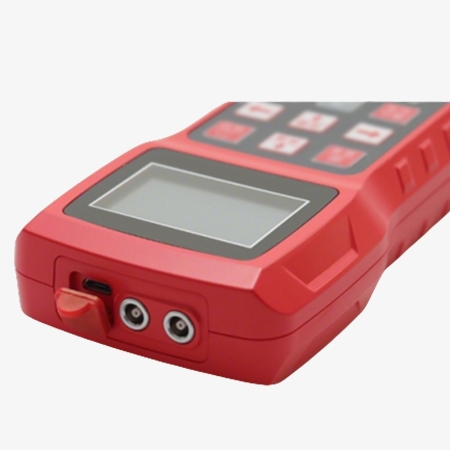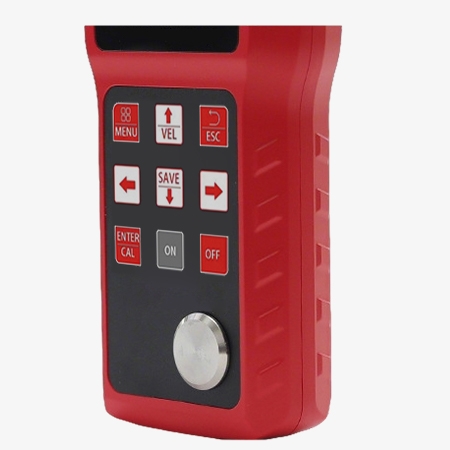The through-coating ultrasonic thickness gauge offers a clear and adjustable display, efficient measurement, extensive data storage, and precise calibration. It is compatible with a variety of materials, offers long-lasting power, is portable and durable, and can operate reliably even in harsh environments.

Precise Measurement and Intelligent Assurance
- The sound velocity range reaches 1000 to 9999 m/s, matching the ultrasonic propagation velocity of most common materials. Two selectable resolution modes, 0.1mm and 0.01mm, meet measurement requirements for varying precision. A precise error compensation mechanism ensures reliable measurement results.
- A coupling status indicator provides real-time feedback on the coupling between the probe and the surface being measured, preventing measurement errors caused by poor coupling. A battery indicator displays the remaining battery charge in real time, providing early warning of low battery conditions and preventing measurement interruptions. Power-saving features such as auto-sleep and auto-shutdown extend battery life.

Easy Operation, Easy Measurement
- The high-brightness white LED backlight and adjustable-contrast LCD display provide a clear and bright display. The adjustable contrast allows users to flexibly adjust the display to suit lighting conditions and their visual preferences, ensuring clear and visible measurement data in both bright and dim environments.
- The through coating ultrasonic thickness gauge achieves a high-speed measurement response of 4 times/second for single-point measurements and 20 times/second in scanning mode, significantly improving batch measurement efficiency. The device also boasts a storage capacity capable of storing 500 sets of thickness measurement data, facilitating subsequent data review, analysis, and report generation, reducing the cost of repeated measurements.
- The r&d coating thickness gauge has probe zero-point and two-point calibration functions that automatically correct for system errors, ensuring accurate measurement results and minimizing measurement deviations caused by instrument-specific errors.
Applications
Key application fields of SISCO pen-type electromagnetic ultrasonic thickness gauge include shipbuilding, aerospace, and automotive industries. The compact, pen-style design makes it convenient for on-site inspections and maintenance, particularly in confined spaces or at height. Additionally, the gauge is useful in quality control during manufacturing processes, helping ensure material integrity and compliance with safety standards.

Shipbuilding Industry

Automobile Manufacturing

Metal Processing

Aviation Industry
| Model | SISCO-UT-XT220 |
| Display Method | white high brightness LED backlight, LCD contrast can be adjusted |
| Measurement Range | 0.75~300mm (depending on the probe), metric and English can be selected |
| Speed Range | 1000~9999 m/s |
| Resolution | 0.1mm/0.01mm optional |
| Indication Accuracy | ± (0.5%H+0.04) mm H is the actual thickness of the measured object |
| Measurement Cycle | 4 times/second for single point measurement, 20 times/second for scanning mode |
| Storage Capacity | can store 500 sets of thickness measurement data |
| Working Voltage | 5 dry batteries 2 AA size alkaline battery series) |
| Continuous Working Time | about 100 hours (without backlight) |
| Shape Size | 150mm×74mm×32 mm |
| Weight | 238g |
Q1: What is pen-type electromagnetic ultrasonic thickness gauge?
A1: A pen-type electromagnetic ultrasonic thickness gauge is a compact, handheld device designed for non-contact measurement of material thickness. Its pen-like design allows for easy access to tight or hard-to-reach areas. This gauge is ideal for measuring corrosion, erosion, and wear in pipelines, tanks, and structural components.
Q2: How to maintain pen-type electromagnetic ultrasonic thickness gauge?
A2: To maintain a pen-type electromagnetic ultrasonic thickness meter, regularly clean the probe and device housing with a soft, dry cloth to prevent dust and debris buildup. Avoid exposing the gauge to excessive moisture, heat, or corrosive environments. Check battery levels and recharge as needed to ensure accurate operation. Periodically inspect the probe cable for signs of wear or damage. Store the device in a protective case when not in use to prevent accidental damage.
Q3: What materials can be measured using this electromagnetic ultrasonic thickness gauge?
A3: An electromagnetic ultrasonic thickness tester is ideal for measuring the thickness of conductive materials. It can accurately measure metals such as steel, aluminum, copper, and titanium, as well as their alloys.
Tips: Coating Thickness Gauge Measurement Principle
The measurement principle of a coating thickness gauge is primarily based on the physical property differences between a coating (such as a coating or plating) and the substrate. Nondestructive testing methods are used for thickness measurement. Common methods include ultrasonic, magnetic, eddy current, and X-ray fluorescence. Ultrasonic methods calculate thickness based on the time difference between the reflection of sound waves at the interface between the coating and substrate. Magnetic and eddy current methods utilize the difference in magnetic permeability or electrical conductivity between the coating and substrate, respectively. X-ray fluorescence determines thickness by analyzing the intensity of X-rays characteristic of coating elements.
Thank you for buying industrial test and measurement equipment on SISCO.com, all products sold by SISCO and the partner cover a 12 months warranty, effective from the date of receiving the products.
What is covered?
SISCO is responsible for providing free spare parts, and free technical support to assist the customer to repair the defective products until the problem is solved.
What is not covered?
- Product purchased from anyone other than a SISCO store or a SISCO authorized reseller.
- Expendable parts.
- Routine cleaning or normal cosmetic and mechanical wear.
- Damage from misuse, abuse or neglect.
- Damage from use of parts other than SISCO approved.
- Damage from use outside the product’s usage or storage parameters.
- Damage from use of parts not sold by SISCO.
- Damage from modification or incorporation into other products.
- Damage from repair or replacement of warranted parts by a service provider other than a SISCO authorized service provider.
- Damage caused by the application environment not meeting the product usage requirements and the failure to perform preventive maintenance.

